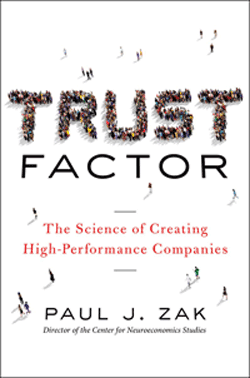Author Paul Zak has pulled the rug out from under my assumptions about managing people. His scientifically-based research and practical book, “Trust Factor: The Science of Creating High-Performance Companies,” explains how trust in organizations is the key to joy and high performance. He writes from a familiar place, my alma mater – Claremont Graduate University and the famous Drucker Center for Management. The author and I share intellectual influences by two of Claremont’s best, Peter Drucker and Mihale Czikszentmihale, two of my professors and his colleagues.
 In addition to teaching psychology, management and economics at Claremont, Zak is an expert on brain functions and the founding director of the Center for Neuro-economics Studies. Much of his research is spent taking blood from willing volunteers to measure neurochemical changes during stressful decision-making and when all is well.
In addition to teaching psychology, management and economics at Claremont, Zak is an expert on brain functions and the founding director of the Center for Neuro-economics Studies. Much of his research is spent taking blood from willing volunteers to measure neurochemical changes during stressful decision-making and when all is well.
His radical approach to high-performance cultures looks at what happens in our brains at different levels of well-being as well as dysfunctional times. He is the first scientist to show that the brain synthesizes the chemical oxytocin when we are trusted and respected. When we feel good about ourselves and our surroundings, we reciprocate trust by being trustworthy.
The book questions old management techniques that treat people as “resources” rather than living and responsive human beings. The old scientific management techniques that focus on extrinsic rewards such as money and material displays for power are questioned for their effectiveness to produce high-performance behavior. Instead, he shows that one’s feelings of joy and satisfaction (oxytocin) are intrinsic drivers in the production of valuable work, which has a multiplier effect on the surrounding community; kindness produces more kindness.
Zak’s research goes back to 2001 when he showed that cultures of trust were the most powerful predictors economists had ever found to explain why some countries are prosperous and others are poor. He states that “…high trust stimulates social interaction and integration and acts as an economic lubricant by reducing frictions inherent among people.”
The author’s research is impressive and the writing flows. Each chapter has end-of-the-book notes with detailed resource information. The main takeaways are the specific methods we can use to create high-performance cultures. He cleverly uses the term “OXYTOCIN” to create the eight key words that trigger the brain chemical. They are:
Ovation: Show appreciation by celebrating the work well done and project completed. Simple and genuine ovations are motivating and enrich an organizational culture.
eXpectation: Create challenging goals to stretch the creativity and engage the brain.
Yield: Let employees take control of their work. Train them well and give them authority to make decisions.
Transfer: Let employees decide how to transfer their skills. Encourage job rotation and flexible integrative learning.
Openness: Share information to encourage the stakeholder effect.
Caring: Show caring and empathy to create bonds of friendship.
Invest: Invest in developing the human talent of employees.
Natural: Be honest about weaknesses to share the human factors of imperfection.
I recommend this book to anyone interested in the powerful side of building trust and creating joyful, high-performance workplaces such as Google, Disney, Life is Good, The Container Store, Whole Foods, SAS Institute and many more, as described in this book. The lessons are basic. They are the essence of being joyful and human.
Lucia Worthington is writing from her edible landscape garden this summer. She also teaches at Clark College. To recommend a book for review, email bookreviews@vbjusa.com.

